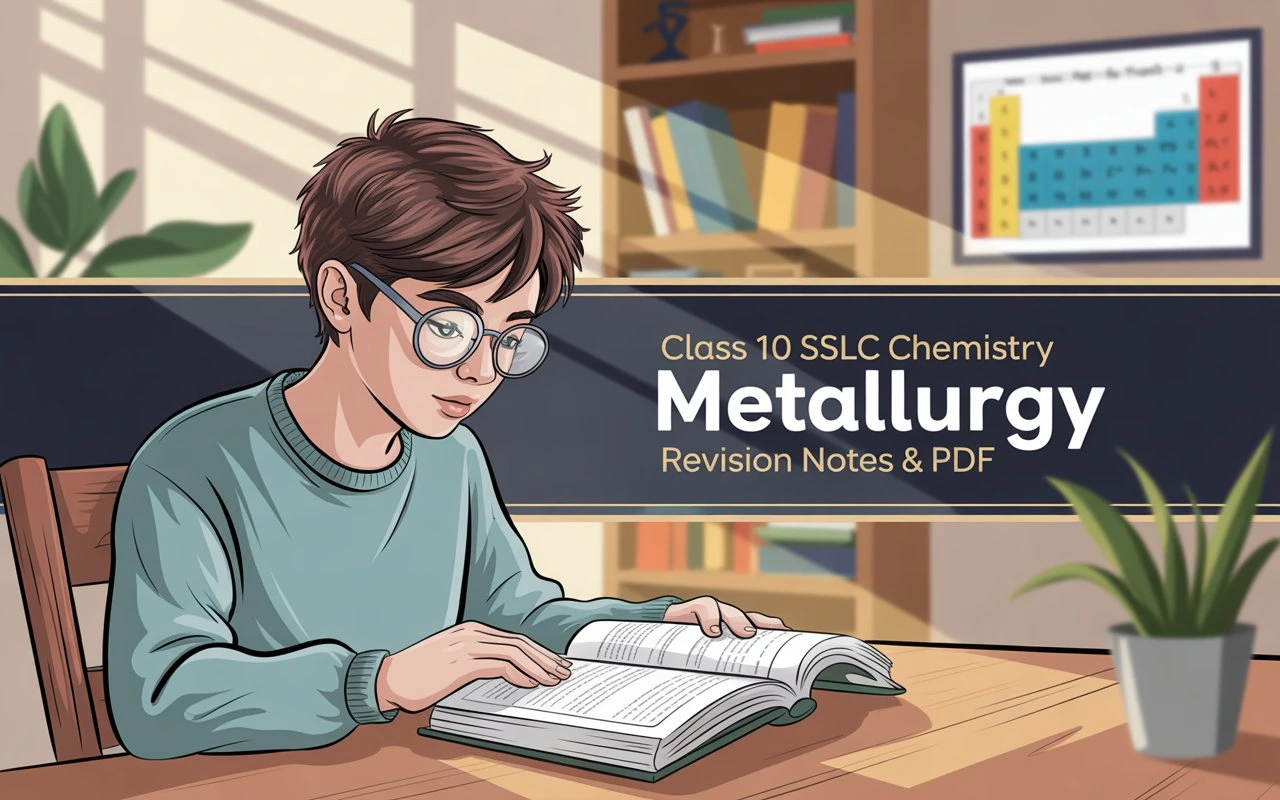Class 10 SSLC Chemistry – Metallurgy Revision Notes & PDF




Metallurgy is one of the most important chapters in the Class 10 SSLC Chemistry Kerala syllabus. It helps students understand how metals are extracted from their ores, a foundation for higher studies in chemistry.
In this article, we’ll go through easy-to-understand revision notes on metallurgy to help you prepare for exams quickly and confidently.
Let’s dive into the key concepts and methods that make metallurgy an essential part of your SSLC chemistry notes.

Metallurgy is the process of extracting pure metal from its ore using scientific methods.
Metallurgy is the science and technology of extracting a metal from its ore conveniently and profitably.
Before learning the extraction steps, it’s important to know three basic terms:
Removing the gangue from the ore is the first step in the extraction process, called Concentration of Ore.
The concentration of ore (also called benefaction or enrichment) is the process of separating impurities (gangue) from the ore to obtain concentrated metal ore.
Different ores have different properties, so the method of concentration depends on how the ore and impurities differ in physical or chemical characteristics.
Let’s look at the four main methods used for the concentration of ores.
Principle:
This method is based on the difference in weight between the ore particles and the impurities.
Process:
The crushed ore is washed in a stream of water. The lighter gangue particles are carried away with the water flow, while the heavier ore particles settle at the bottom.
Example:
Used when the ore particles are heavier than the impurities, such as in oxide ores of tin and gold.
Principle:
Used when either the ore or the gangue has magnetic properties.
Process:
The powdered ore is passed over a conveyor belt fitted with a magnetic roller.
Example:
Used to separate magnetic ores like magnetite (Fe₃O₄) from non-magnetic impurities.
Principle:
This method is based on the difference in wetting properties of the ore and gangue particles.
Process:
The powdered ore is mixed with water and a small amount of oil (usually pine oil) in a large tank. When air is blown through the mixture:
The froth containing the concentrated ore is then collected and dried.
Example:
Commonly used for sulfide ores like zinc blende (ZnS) and copper pyrites (CuFeS₂).
Principle:
Used when the ore particles dissolve in a particular solvent, leaving behind the impurities.
Process:
The ore is treated with a suitable chemical solution that dissolves the desired metal compound while leaving the impurities undissolved.
The solution is then filtered, and the metal is recovered from the filtrate by further chemical reactions.
Example:
Leaching is widely used for the extraction of aluminium from bauxite ore using sodium hydroxide (NaOH).
The reaction forms a soluble compound called sodium aluminate, which is later processed to get pure aluminium oxide.
Metallurgy is not just another chapter; it is a concept that links chemistry to real-world applications like metal extraction, recycling, and engineering.
In the Kerala Board SSLC Chemistry syllabus, this topic frequently appears in:
Having a clear understanding of each method helps you answer both theory and practical-based questions confidently in your board exam.
Metallurgy may seem like a detailed topic, but once you understand the basic principles, minerals, ores, gangue, and concentration methods, it becomes very easy to remember. These revision notes will help you recall key points quickly before your SSLC Chemistry exam.
If you’re preparing for your Class 10 SSLC exams, you might feel the syllabus is too vast or that time is running out. That’s where Interval Learning’s SSLC Crash Course can help.
A crash course is a short-term, intensive learning program designed to cover the most important topics and exam strategies in less time.
This course is perfect for students who want to revise efficiently, strengthen their weak areas, and improve scores without feeling overwhelmed.
Reading notes is great, but seeing the process makes it even easier to remember.
You can watch our full explanation video in Malayalam here:
This video simplifies each method visually, ideal for last-minute revision before exams. It’s part of Interval Learning’s effort to combine text-based notes and video learning for better concept clarity.
Join Interval Learning’s SSLC Crash Course today and make your exam preparation smarter, faster, and more focused on results. Contact us today!
Metallurgy is the process of extracting metals from their ores using physical and chemical methods.
The four main methods are Hydraulic Washing, Magnetic Separation, Froth Flotation, and Leaching.
Bauxite ore is concentrated using the Leaching process with sodium hydroxide (NaOH).
A mineral is a naturally occurring compound containing metals, while an ore is a mineral from which a metal can be extracted profitably.
It helps students understand real-world applications of chemistry and is frequently asked in board exams.
It covers topic-wise revision, past paper practice, shortcuts, and one-on-one tutoring for better exam preparation.
You can contact Interval Learning directly through their website to enroll and start preparing with expert tutors.
Important topics in Class 10 SSLC Chemistry Metallurgy include the occurrence of metals, extraction of metals from ores, refining methods, reactivity series, and corrosion prevention. Students should also understand examples like extraction of aluminium, zinc, and copper for better exam preparation.
You can download SSLC Metallurgy Revision Notes & PDF from trusted educational platforms like Interval Learning. These notes are short, clear, and ideal for last-minute revision before the Class 10 Chemistry exam.
SSLC Metallurgy Revision Notes simplify complex topics and include key definitions, equations, and diagrams. They help students quickly recall important points during revision and boost confidence before the Class 10 SSLC Chemistry exam.